Art Commission Weighs Transitional Role
Ann Arbor public art commission meeting (March 26, 2014): At its first meeting since the city council transferred most of the money out of the public art fund, public art commissioners discussed their role as the city transitions to a new model for managing public art. The former Percent for Art program had set aside 1% for art in capital project budgets, drawing on a range of different funds. The council’s March 3, 2014 action transferred that money back to its funds of origin.
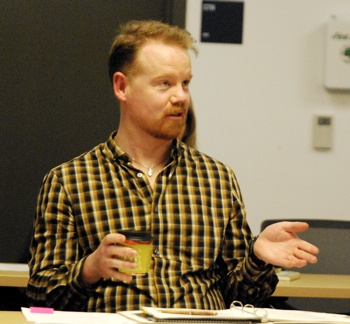
Jim Simpson, the newest member of the Ann Arbor public art commission, attended his first AAPAC meeting on March 26. (Photos by the writer.)
Before the council’s action on March 3, about $943,000 had been available for future public art projects. The council had halted the Percent for Art funding mechanism last year, and subsequently directed city staff to develop a transition plan for public art. The plan will be delivered to the council in October, and will likely include an emphasis on partners in the private sector and fundraising from the community. Meanwhile, future city public art will be “baked in” to selected capital projects and approved by council on a case-by-case basis.
The proposed 2015 budget – for the fiscal year beginning July 1, 2014 – includes $80,000 to cover transitional costs for public art administration. The contract for the current part-time public arts administrator, Aaron Seagraves, runs through June 30, 2014. At AAPAC’s March 26 meeting, Craig Hupy – a senior city staff member who’s drafting the transition plan – mentioned the need for a consultant to help guide this process.
Commissioners questioned what their role might be during this interim period, now that former Percent for Art funding is unavailable for future public art projects. After the discussion, AAPAC chair Bob Miller said he had initially considered suggesting that they just shut down the commission, but he’d heard input to the contrary from other commissioners. The consensus was to move forward with meetings, at least for now. AAPAC’s next meeting is on April 23 at city hall.
In other action, commissioners postponed adopting an annual public art plan, and directed Seagraves to make revisions to the draft he had proposed. They’ll consider a new version at their April meeting.
Updates about ongoing projects focused on efforts that had started before the city council pulled funding. The funds for those projects were not affected. Sculptures for a rain garden at Kingsley & First will be installed in May, and more contributions are being sought for a Coleman Jewett memorial at the Ann Arbor farmers market. A public forum to seek input on the final design for artwork at East Stadium bridges will be held on Monday, April 21 at 7 p.m. at the downtown library, 343 S. Fifth. And work on Canoe Imagine Art – a temporary art display in downtown Ann Arbor using old canoes from the city that would be repurposed as public art – continues to move forward.
It was the first meeting for Jim Simpson, who was appointed to AAPAC in February. He works for the Ann Arbor start-up Duo Security, and is an assistant at Baron Glassworks in Ypsilanti.
Future of Public Art in Ann Arbor
At the start of the March 26 meeting, AAPAC chair Bob Miller gave an update on the status of the city’s public art program. The city council had voted not to fund new projects, although current projects can be completed, he said. That includes artwork for East Stadium bridges, the rain garden at First and Kingsley, and two projects that involve partnerships between the city and other entities – Canoe Imagine Art, and a memorial for long-time educator Coleman Jewett, who died last year.
By way of background, the former Percent for Art funding mechanism required 1% of all capital fund project budgets to be set aside for public art. A new approach to public art was established on June 3, 2013, when the council eliminated the Percent for Art mechanism from the ordinance. The new approach entails including city-funded art when it’s designed with council approval as an integral part of a capital project. Art projects also could be funded through a combination of private and public money.
This approach was part of a set of recommendations made by a council committee about a year ago. [.pdf of council committee's public art findings and recommendations] The five councilmembers serving on that committee included Margie Teall (Ward 4), as well as all of those who subsequently declared their candidacy for mayor in the 2014 Democratic primary: Sabra Briere (Ward 1), Sally Petersen (Ward 2), Christopher Taylor (Ward 3) and Stephen Kunselman (Ward 3). That committee work came in the wake of a failed public art millage that was on the ballot in November 2012 – which would have provided an alternative to the Percent for Art funding mechanism.
More recently, on March 3, 2014 the city council took three actions. The council (1) directed the city administrator to establish a budget for public art administration for the next two years; (2) transferred $943,005 out of the public art fund; and (3) extended the contract for the city’s part-time public art administrator through June 30, 2014. The direction in (1) is reflected in the budget that the city administrator will propose on April 21 to the city council – in the form of an $80,000 one-time expense for art administration.
Miller and John Kotarski, AAPAC’s vice chair, have been meeting regularly with Craig Hupy, the city’s public services area administrator who oversees the public art program, to talk about how to move forward. They’ve talked about how to implement changes that the council would like to see, Miller reported, such as moving toward more of a public-private hybrid program. Because neither he nor Kotarski have a background in art management, Miller said, they’ve been talking about possibly finding someone to help guide the city through this transition.
Miller wanted to talk with other commissioners about the role of AAPAC.
Hupy weighed in, saying he wished he could present a sharper vision of what the future would hold. He said he’d been charged with delivering a transition plan to the council in October. There’s clearly an expectation for more public-private partnerships, he said, but also the expectation that public art will be incorporated into capital projects on a case-by-case basis. He’s been wrestling with how to designate projects in the capital improvements plan (CIP) that will be enhanced with public art. That’s a topic that he’s talked with Miller and Kotarski about, Hupy said.
When a transition plan is presented in October, Hupy said, “that doesn’t mean that it’s finished. It’s just a plan to get wherever we’re going.” The expectation is that a transition could take several years.
Hupy didn’t think there was a “doom-and-gloom picture that the public art program within the city is dead. I look at it as transforming.”
Marsha Chamberlin wondered what kinds of topics will be addressed in the transition plan. Hupy said he wasn’t sure yet, adding that his vision at this point would include both public-private partnerships as well as enhanced CIP projects. “I’m very malleable at this time,” he said. The public art program might be housed within the city or with an entity outside the city government. “We’ve got to start with a clean slate, and I’m not presupposing that because something is here today it would be here tomorrow.”
Connie Brown asked whether the city council had a strong vision or goal for the public art program, or whether councilmembers simply had a desire to move away from the Percent for Art funding. Miller said his impression is that the council has primarily stated what it doesn’t want.
Hupy offered to provide a copy of the council’s committee report on the public art program. [.pdf of council committee's public art findings and recommendations] He said that although the council removed some aspects of the program, “it left us a pretty blank palette to paint.” AAPAC can recommend what comes next, he said.
Kotarski thought the goal was to transition away from larger, taxpayer-funded public art. Instead, the council wants to move toward “baked-in” art that’s recommended as part of capital projects. The rest of the funding would be raised through a variety of other mechanisms, he said. “Transitioning is not the art commission’s task,” Kotarski added. “It is Craig’s task.”
Miller noted that there are four projects underway: East Stadium bridges, the rain garden at First & Kingsley, Canoe Imagine Art and the Coleman Jewett memorial. “Other than that, we really don’t have a whole lot on the table,” he said. Miller questioned what the role of AAPAC should be during this transitional period.
Miller said commissioners could “choose to wind things up and wait for a recommendation from the city.” He floated the idea of recommending approval for the East Stadium bridges artwork via email, and not holding any more meetings until given direction by the city. The other alternative is to keep meeting every month and talking about public art in general. He asked for feedback from other commissioners.
KT Tomey suggested meeting at least occasionally. Commissioners could talk about public art that’s happening in other cities, for example, to inspire ideas that might be used in Ann Arbor. “We’re so busy with the process that a lot of times we don’t get the chance to talk about different art projects,” she said.
Chamberlin asked whether any of the city’s staff is compiling information about other cities that have public-private art programs. AAPAC is a recommending body, she noted, and understanding more about how those public-private partnerships work would be useful.
Hupy said that it’s been strongly suggested to him to do a survey of “community appetite” for public art and options for how to manage a public art program. He sees this as something that would happen after a transition plan is presented to council, however. If the city hires someone to help guide this transition, he added, that person likely would be responsible for benchmarking with other communities, among other things.
Hupy said that any funding that might be available for this type of consultant wouldn’t be available until July 1, 2014 – the start of the FY 2015 fiscal year. [The proposed 2015 budget – for the fiscal year beginning July 1, 2014 – includes $80,000 to cover transitional costs for art administration.]
Kotarski reported that Sue McCormick, the administrator who previously held Hupy’s position, had done a benchmarking survey to look at how other communities handled their public art programs. Hupy clarified that McCormick had looked only at communities that had a Percent for Art funding mechanism, or something similar. Kotarski noted that almost every community had some supplemental funding approach to the Percent for Art, and didn’t rely exclusively on that funding mechanism. “Ann Arbor was one of the few that put all its eggs into the Percent for Art basket,” Kotarski said.
Chamberlin suggested that Americans for the Arts would be a good resource for benchmarking.
Brown was in favor of AAPAC meeting during this transition. Outreach and education are important functions that commissioners can continue to undertake, she said. Brown hoped that AAPAC and the council would create a common vision for public art, rather than simply things to avoid.
Hupy said that Robert Keller, a communications specialist for the city, could be enlisted to help promote the public art projects, including the completion of the First & Kingsley rain garden later this year.
Miller asked Hupy how he envisioned AAPAC working during the transition. Hupy replied that AAPAC shouldn’t “meet just to meet.” However, as he works on a transition plan, Hupy said, there will be times when he’ll need feedback from AAPAC.
Chamberlin said she could use help with the Canoe Imagine Art and Coleman Jewett memorial as well. “I’m in favor of meeting because it keeps us engaged and informed,” she said.
Jim Simpson suggested continuing to meet monthly, until it’s clear that there’s nothing valuable coming out of the meetings. There’s an opportunity for leadership as well, he said.
Kotarski agreed that no matter what Hupy and the council ultimately decide, AAPAC will likely be asked “to be the community’s eyes and ears about whatever the public art program ends up being. So the more we function as a team, the better.”
Miller said he had originally envisioned just shutting down the commission, and he was glad to hear input to the contrary. The consensus he was hearing was to move forward with meetings.
The other issue is the contract for the public art administrator, Miller said. The current contract with Seagraves runs through June 30, 2014 – the end of the current fiscal year. Miller wondered what happens next.
Seagraves replied that there will be a recommendation for public art administration in the FY 2015 budget, which the council will be asked to approve in May. He thought AAPAC should plan to meet in April.
Outcome: This was not a voting item.
Public Art Annual Plan
The March 26 agenda included final approval of the public art annual plan, which AAPAC had initially reviewed at its Jan. 29, 2014 meeting. AAPAC did not meet in February. [.pdf of draft annual plan for FY 2015, as presented on March 26]
In previous years, a public art annual plan was required to be submitted to the city council by April 1. But at AAPAC’s April 24, 2013 meeting, commissioners voted to recommend shifting that date to Feb. 1 – a move intended to allow the council to make budget decisions based on recommendations from AAPAC. Shifting the date of the annual plan was linked to a major restructuring of the city’s public art program, which is still underway. The city council subsequently made revisions to the public art ordinance – Chapter 24 of the city code – that included the Feb. 1 deadline for submitting the annual plan.
This year, commissioners voted to approve a draft annual plan at their Jan. 29, 2014 meeting. They also directed AAPAC vice chair John Kotarski to work with public art administrator Aaron Seagraves to make final revisions to the plan, based on feedback from their Jan. 29 discussion. [.pdf of draft plan discussed on Jan. 29]
The plan considered on March 26 listed seven goals for the upcoming fiscal year, from July 1, 2014 through June 30, 2015:
- Maximize the ability to use gifts, grants, crowd funding and other non-local government funds for public art in Ann Arbor, as the amended Public Art Ordinance allows.
- Review the location of the arts program within Ann Arbor city government and review the possibility of containing the public art program within a nonprofit organization.
- Fulfill the Public Art Task Force’s recommendation of creating a position for a full-time public art staff person.
- Increase public outreach for long-term public art program goals, artwork selection, and artwork education and thus better carry out the duties of the Public Art Commission established by the Ordinance amendment.
- Refine the selection of potential public art projects by using the project evaluation and prioritization model and base the initiation of projects on primary criteria.
- Revise the Public Art Commission’s Bylaws and Guidelines.
- Establish an open and regular channel of communication regarding public art program updates with city administration and City Council.
The plan included projects that are already underway, as well as proposed capital projects to be enhanced with public art. The ongoing projects are: (1) artwork for East Stadium bridges; (2) public art at Arbor Oaks Park; (3) Canoe Imagine Art; and (4) the Coleman Jewett memorial.
The proposed enhanced capital projects are street and sidewalk stamping, painting or stenciling in four locations to be determined, for a total cost of $30,000. Craig Hupy, the city’s public services area administrator, stressed that the city council would need to approve these projects before they would move forward. City staff would be involved in developing guidelines for these installations to “ensure the artwork will meet all applicable codes, are safe for all pedestrians and are compatible with the maintenance of the infrastructure,” according to the plan.
Marsha Chamberlin asked whether the commission had previously seen and formally approved these goals. [Chamberlin had been absent from the Jan. 29 meeting, and AAPAC did not meet in February.] Kotarski replied that these are based on the goals of the city council committee that had recommended changes to the public art program last year.
Chamberlin objected to the first goal: “Maximize the ability to use gifts, grants, crowd funding and other non-local government funds for public art in Ann Arbor, as the amended Public Art Ordinance allows.” The commission might explore the feasibility of doing this, she said, but it’s not clear that it should be a goal. She also noted that the goal of revising the bylaws is really just a management function.
Kotarski replied that the council’s public art ordinance revisions incorporated aspects of these goals, and the commission is governed by the ordinance. “So we really can’t function outside that ordinance,” he said. It’s important that the council knows that AAPAC “gets it,” he added, and that commissioners will work to achieve the changes in the ordinance.
Seagraves, who drafted the annual plan, said these aren’t just annual goals. It’s an indication that the commission will address these issues. In that case, Chamberlin urged that the goals be moved within the document so that it’s clear the goals don’t apply just to FY 2015. She also wanted to change the wording on the first goal, to indicate it would be something the commission would work toward.
Chamberlin also questioned the second goal: “Review the location of the arts program within Ann Arbor city government and review the possibility of containing the public art program within a nonprofit organization.” She said she hadn’t ever been in a meeting when this idea had been discussed. “I didn’t realize that was really a goal of the public art program,” she said.
Bob Miller, AAPAC’s chair, said these ideas had been discussed in meetings that he and Kotarski have had with Hupy. Chamberlin replied: “But you’re asking us to approve a public art plan that has things in it we haven’t discussed.”
Connie Brown suggested clarifying the discrepancy between what AAPAC does, what the council committee recommended, and what the staff responsibilities are. Specifically, she thought clarity was needed for goals 2, 3 and 6.
Hupy noted that although there’s a deadline for submitting the annual plan to council, “the deadline has long passed.” He thought it warranted more discussion and revisions, until the commission felt comfortable with the document.
Outcome: Commissioners voted to postpone a vote on the annual plan until its April 23 meeting.
Community Foundation
The commission considered a resolution requesting that the Ann Arbor Area Community Foundation seek variances from donors who had previously contributed funding for: (1) a project at the Fourth and Washington parking structure; and (2) a project in the South University area that was never completed. Remaining money from those projects is being held in special funds by the AAACF. [.pdf of resolution]
The variance, if granted by donors, would allow those remaining funds to be used for other public art projects, or to be put into an endowment for public art. The endowment is for maintenance of public art. Bob Miller, AAPAC’s chair, reported that the community foundation has asked that AAPAC pass this resolution. The purpose is to free up the money, though there isn’t a specific project that it would be used for at this point, Miller said.
There’s $13,200 remaining in the Fourth & Washington parking structure fund, and $1,100 in the South University fund.
Aaron Seagraves, the city’s public art administrator, noted that a variance has already been granted for remaining money in a third public art fund held by AAACF. That money had originally been donated for public art on Fourth Avenue, and has now been designated to “support the creation of a future work of public art in the Ann Arbor downtown area.” The amount in that fund is $10,930.
So in total, the community foundation is holding $25,230 designated for public art, in addition to a maintenance endowment. Seagraves didn’t have information at the meeting about the amount of funds in the endowment.
Marsha Chamberlin advocated for limiting the variance to freeing up money for other public art projects – that is, not to provide donors with the option of putting it into an endowment. She noted that the city’s public art projects each include a 10% set-aside for future maintenance costs.
Hupy replied that for current public art projects, the routine maintenance is the responsibility of the city facility that’s “hosting” the artwork. For example, a sculpture in the parks is the responsibility of the parks and recreation unit. However, non-routine work would be funded through the endowment. A few years ago, the sculpture in Sculpture Plaza at Fourth and Catherine used the endowment in part to pay for significant repairs.
Chamberlin noted that after money is put into a maintenance endowment, it’s locked up – it can’t be pulled out later for other purposes.
Chamberlin suggested wording the final resolved clause to state: ”RESOLVED, To request donors use their donations to support future art projects as reviewed and selected by AAPAC.” The amendment was accepted as friendly.
Outcome: Commissioners voted unanimously to pass the resolution, as amended.
Project Updates
Commissioners were updated on projects that are currently underway: (1) the Coleman Jewett memorial; (2) Canoe Imagine art; (3) sculptures at a rain garden at Kingsley & first; (4) artwork for East Stadium bridges; and (5) a possible project at Arbor Oaks Park. [.pdf of project report memo]
Project Updates: Coleman Jewett Memorial
A bronze replica of an Adirondack chair made by Coleman Jewett will be located at the Ann Arbor farmers market. Jewett was a long-time local educator who died in January of 2013. After he retired, he made furniture that he sold at the Ann Arbor farmers market. AAPAC has committed $5,000 in city funds to the project, which has a total project budget of $36,000. Other funds will be raised from private donations, including a contribution from the Old West Side Association.
Marsha Chamberlin reported that as of March 26, the project had raised $17,833 in contributions. It doesn’t include the $5,000 that has been committed by the city. Estimates from three foundries came in at about $25,000, so there’s enough money at this point for the project to move ahead, she said. To raise additional funds, a party was being planned with alums from Tappan Middle School, where Jewett was assistant principal.
A request for proposals is being developed to solicit firm bids for the work. Depending on how quickly the RFP is issued, it might be possible to get the memorial installed by late fall, Chamberlin said.
She cautioned that the ability to raise funds for this project is tied to the affection that people in the community had for Jewett. Even at that, many of the gifts are small, she noted. Her point, Chamberlin said, is that “it’s not a slam dunk to raise money for something like this.”
Project Updates: Canoe Imagine Art
Canoe Imagine Art, a community art project, will entail a temporary art display in downtown Ann Arbor using old canoes from the city that would be repurposed as public art. The installation of an estimated 25-30 canoes is expected to take place in fiscal 2015 or 2016, depending on funding. The project has received a $21,000 grant from the Michigan Council for Arts and Cultural Affairs, and organizers plan to raise additional funds from private donors.
AAPAC originally approved $10,000 in funding for the project, at its Sept. 25, 2013 meeting. It was to be used as a portion of matching funds for the state grant, with the remaining $11,000 in matching funds to be raised through donations. However, the city council voted to allocate the entire $21,000 in city funds to match the state grant. That action came at the council’s March 3, 2014 meeting.
Marsha Chamberlin reported that she’s been talking to community partners – including the Ann Arbor District Library, Leslie Science & Nature Center, and the Ann Arbor Civic Band – who’ll be putting on ancillary events tied to the art installation. The project also is seeking a grant from the Ann Arbor Area Community Foundation.
Chamberlin said that the city attorney’s office has suggested trying to get another organization other than the city to be the administrator of this effort, in order to simplify things. She hoped that it would be sorted out in April so the project could move forward.
In a follow-up interview with The Chronicle, Chamberlin reported that the Ann Arbor Convention & Visitors Bureau is being asked to serve as an umbrella organization for this project, which could entail handling the finances and hiring a project manager. No decision has yet been made, however, and another meeting is planned on April 22 with city staff, AAPAC members, the CVB and the Ann Arbor Area Community Foundation. The nonprofit Arts Alliance, which might seem like a better fit, charges a 30% fee for project management, Chamberlin noted. The Michigan Council for Arts and Cultural Affairs, which has provided a grant for the project, would not allow for a management fee of that size.
Project Updates: Kingsley & First Rain Garden
The installation of sculptures in a rain garden at the southeast corner of Kingsley & First is planned for May. The rain garden itself will be constructed in mid-May, with the artwork installed later that month.
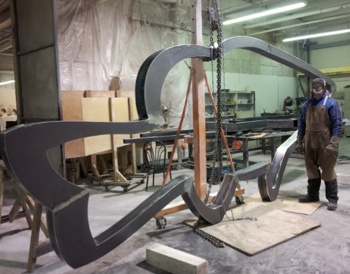
One of the sculptures being fabricated for the Kingsley & First rain garden. This photo was provided in AAPAC’s March 26 meeting packet.
At their Aug. 28, 2013 meeting, commissioners had approved Joshua Wiener‘s schematic design for public art at a planned rain garden. [.pdf of staff memo, including itemized budget]
The Denver artist is working with landscapers to incorporate public art into the new rain garden, which is in a floodplain. The project has a $27,000 budget, though the artist’s contract would be for $23,380.
Wiener’s sculptures show the outlines of five fish. They’re small mouth bass, in different sizes, made of white epoxy-painted steel and pointed toward the Huron River. The largest sculpture will be just under 8 feet tall, 20 feet wide and about 5 feet deep. Two of the fish will be large enough to serve as benches.
Connie Brown will be spearheading communications about this installation, including an event tied to the completed project, with the artist attending.
Project Updates: Arbor Oaks Park
This project is being undertaken in partnership with Bryant Neighborhood Association and the nonprofit Community Action Network, which is under contract with the city to run the Bryant Community Center. It will involve participation of the neighborhood in the design and creation of the artwork.
Aaron Seagraves, the city’s public art administrator, reported that the project applied for a grant from the Southeast Michigan Community Foundation, but did not receive it. No city public art funds have been allocated, and additional funding is expected to be raised through community donations.
Seagraves reported that AAPAC member Nick Zagar is coming up with a proposal to discuss with the project’s task force. [Zagar did not attend AAPAC's March 26 meeting.] Seagraves also will be talking with the city’s parks staff about possible options, as the city plans to install new playground equipment there.
Project Updates: East Stadium Bridges
Aaron Seagraves, the city’s public art administrator, reported that Bob Miller and John Kotarski were making presentations about the final design for artwork at East Stadium bridges, attending meetings of local public entities like the city’s park advisory commission and the Ann Arbor Downtown Development Authority.

An image by artist Catherine Widgery for artwork on the East Stadium bridge. This night view shows how the structures would be lit from below, illuminating the images of trees that are etched into louvered glass panels.
The intent is to get feedback on the proposed design before bringing it back to AAPAC for a recommendation of approval. The city council will be asked to give final authorization to the project.
In early August of 2013, Catherine Widgery of Cambridge, Mass. was recommended as the artist for this project. She was picked by a selection panel from four finalists who had submitted proposals for the project, which has a $400,000 total budget. [.pdf of Widgery's original proposal]
The selection panel provided feedback to Widgery and asked that she revise her proposal before it’s presented to AAPAC and then later to the city council for approval. Members of the panel are Wiltrud Simbuerger, Bob Miller, Nancy Leff, David Huntoon and Joss Kiely. [.pdf of panel feedback]
A public forum to get additional feedback will be held on Monday, April 21 at 7 p.m. at the downtown library, 343 S. Fifth Ave.
More details on the presentation by Kotarski and Miller are included in The Chronicle’s report of the Ann Arbor planning commission’s April 1, 2014 meeting.
Communications & Commentary
Every meeting includes several opportunities for communications from staff and commissioners, as well as two opportunities for public commentary. Here are some highlights from March 26.
Communications & Commentary: New Commissioner
Jim Simpson was attending his first meeting since being appointed to AAPAC on Feb. 3, 2014. The commission did not hold a meeting in February. He told the group that he watched the city council meeting when his appointment was confirmed, noting that it was the same meeting when the future of public art had been debated – “so I had mixed feelings.”
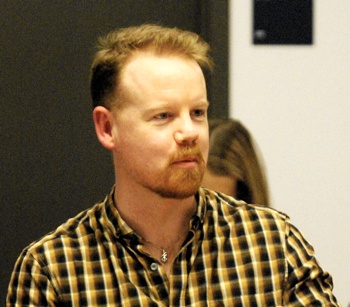
In addition to his job at Duo Security, Jim Simpson is an assistant at Baron Glassworks in Ypsilanti.
He reported that he watches city council meetings because he’s interested in seeing how the city grows and develops, and he wants to become more invested in the city. His family is from California, and he attended the University of Michigan as an undergraduate. When he graduated, he decided to stay here. “A lot of my California family doesn’t understand this,” he joked, “but we do have water here and they don’t, so that’s a plus in my opinion.”
His background is in computer science and Japanese, and he works for a start-up company called Duo Security, which focuses on network security. His job is product manager, interacting between sales, marketing and development.
As far as an artistic background, Simpson told commissioners that he blows glass. He’s been an assistant at Baron Glassworks in Ypsilanti for the past five years. He decided to get involved in AAPAC after seeing the request for proposals for art at East Stadium bridges, so he submitted his name for consideration. He said he was excited to be there.
Communications & Commentary: Public Commentary
Changming Fan, who in recent months has been attending meetings of many city boards and commissions, spoke about his company, TiniLite World Inc., which is based in Ann Arbor. The firm is the innovator, producer and supplier of new technology called TiniLite, he said. It’s a lighting display using LED lights, cell phones, and wireless Internet. He called it the light of art, and the art of light, and hoped that the city would use the technology for the public’s benefit.
Commissioners present: Ashlee Arder, Connie Brown, Marsha Chamberlin, John Kotarski, Bob Miller, Jim Simpson, Kristin Tomey. Also: Aaron Seagraves, the city’s public art administrator and Craig Hupy, public services area administrator.
Absent: Devon Akmon, Nick Zagar.
Next regular meeting: Wednesday, April 23, 2014 at 4:30 p.m. in the basement conference room at city hall, 301 E. Huron St. [Check Chronicle events listing to confirm date]
The Chronicle relies in part on regular voluntary subscriptions to support our artful coverage of public entities like the Ann Arbor public art commission. Click this link for details: Subscribe to The Chronicle.




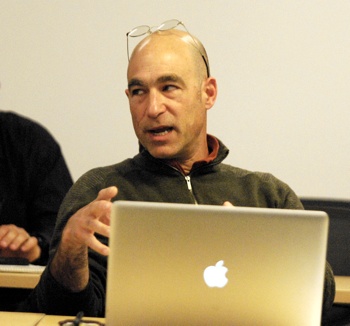
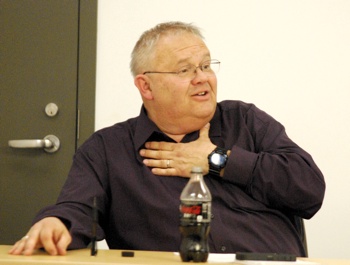
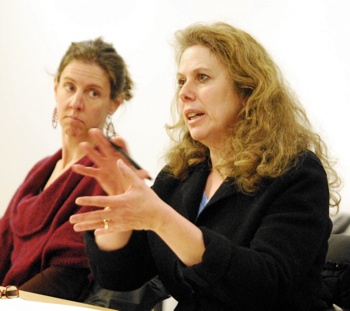
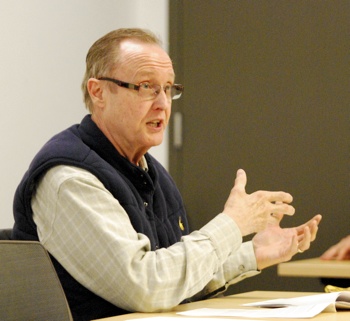
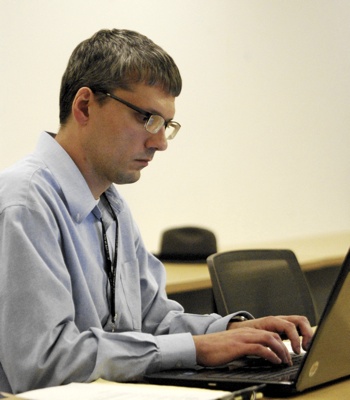


Public art is something I feel is important to the city. I served 6 years on CAPP, the predecessor of the current art commission, most of that time as chair. Many of the projects we completed were funded largely by private donations, with some in-kind services kicked in by the city.
The current art commission had a run of years when they were flush with money. Now that time is over. Judging only by the sense I get from this article, an air of defeatism seems to have overtaken this commission. Surely people who are passionate about public art can’t seriously entertain the thought of just giving up and going home.
I suggest that, rather than look at what the city allow, they should turn the telescope around. Decide on a vision of what public art should look like in Ann Arbor, and find a way, using the city’s resources, or other community resources, and start working to get something done.
Even without a lot of money, the art commission occupies a place of public, and political, visibility. The commission is in a position to encourage and unleash the public art impulses of the city. A city that prides itself, at least theoretically, on diversity probably has scores of people and plenty of community resources willing to make public art a reality.
If the current commission can’t provide the vision and leadership that we need now, perhaps it’s time for different people on the commission.
I would go further to say that if the current City Council can’t provide the vision and leadership that we need now, perhaps it’s time for different people on the Council. Recent ham-fisted actions taken by certain members of Council have lead to the demoralization of the AAPAC and the local arts community. Judging from the latest (and last?) projects, AAPAC has the vision necessary for a great Public Arts program, and enhances the quality of life here in Ann Arbor.
As Bob Elton points out in comment (1), Ann Arbor had public art before the percent for arts program. It will have public art after the discontinuation of that program.
The percent for arts funding mechanism was a clever method of obtaining funding without seeking voter approval. For a variety of reasons, the program became unpopular with voters. When finally the Council sought voter approval of an arts millage, that proposal failed. I believe the very tiny arts millage request (1/10 of a mill) failed due to voter frustration with the percent for arts program.
Following the failed millage, Council formed a committee to make recommendations about public art. That committee recommended that the percent for art program be ended. It also recommended that the City design some sort of transition from the previous art program to one that would better tap into private funds.
Council, at that time, could not agree on what to do with the uncommitted percent for arts funds that had accumulated prior to the end of the program. The money was left sitting in the arts account.
Art money derived from restricted sources, such as the street millage or from water and sewer fees, could only be used for art that was sufficiently related to the source of the funds. On the other hand, the Arts Commission had the authority to spend small amounts of money in the arts fund without seeking Council approval.
Had the unencumbered arts funds been allowed to remain in the arts fund, there was the real possibility that some restricted funds would be spent on matters not directly related to the restricted source of those funds. Returning those funds to their source accounts prevented inadvertent misuse and also saved us the task of buying art, not because it was desirable, but because it was arguably related to the source of the funding.
The Art Commission no longer is obligated to find ways to spend accumulated funds. Instead, the Commission can seek art that is so compelling that the community will agree that we must find a way to afford it. Affording art may require private contributions and creative fund raising. Public art should be capable of generating that excitement.
Remember when the Mayor withdrew his nomination of Jeff Hayner for the Art Commission after Jeff announced he’d filed to run against Sabra Briere for her First Ward City Council seat?
Remember his reasoning was he did not appoint City Council candidates to board or commission seats?
Mr. Hayner never got an appointment – even after the election was over – others were appointed instead.
Hayner deserves the next open seat on the Art Commission.
Mr Eaton, you continue to talk about failure when you respond to any of my posts, methinks you doth protest too much. In my opinion, you are the one who has failed. You have failed to convince me and many other Ann Arborites that Public Art has a place in the future of Ann Arbor. You failed to give the Percent for Arts program a chance to get off the ground. You failed to give the AAPAC a chance as well. What kind of Public Art will you propose to put on, around, or in your new park? How will you fund that? In this, you have failed to inspire me to support your pet park project that not everybody in Ann Arbor wants.
You and your little group of curmudgeons have failed to outline what your back-up plans are once you tear down all of the Hieftje projects and proposals. Your statements in particular fail to enlighten the public about back-up plans, whether the issue is Public Art, or Fuller Road Station, or the Edwards Brothers property giveaway to the University. Go ahead, keep focusing on failure. I can’t wait for the day you fail to keep your Council seat.
Dave & Mary, As always, your work is stupendous and extremely important. Question: do you have any policy regarding name-calling by commenters? I for one don’t usually read comments by Fuzbollah anymore, but after scanning thru #2 & #5, I’m surprized they were approved. One of Fuz’s main tactics is name-calling, not something I ever see in your comments except by Fuz. Also, using an obvious play on words (Hezbollah) makes light of a situation where people are suffering and dying. Thank you in advance for any consideration you can give this matter.
Re: [6]
Libby, the Chronicle’s commenting policy is sketched out here: [link].
The vast majority of comments never enter the moderation queue because the default is automatic approval – with the provision that a comment from a first-time commenter is automatically sent to the moderation queue.
Various other technical reasons [hyperlinks, inclusion of various "watch words" typical of trolling comments (I don't think "curmudgeon" is on that list)] can also trigger assignment to the moderation queue.
Once a comment has appeared, we typically leave it in place, even if it doesn’t comply with the basic principle of “Be Generous.” On rare occasion, we’ve moved a comment to the Orphaned Comments page. If I were looking for reasons to banish comments to the Orphaned Comments page – on the grounds that they were not generous or that they engaged in gratuitous personal attack – I’m sure I could spend a chunk of time every day policing comments and arguing the nuances of meaning of words with commenters who feel aggrieved that their comment has been banished but some other comment has not been banished, even though the other comment was a more flagrant violation of whatever principle, etc. So I’m typically not looking for reasons to banish comments. Over the last five and a half years, I’d say that the customary reaction of readership to comments that don’t hew to the “Be Generous” principle has been, in responding, to “Be Generous Anyway.”
That basic approach has allowed me to spend almost no time ever policing comments, and I would like to keep it that way.
In closing, I would not like meta-commentary on the merits of other comments with respect to the commenting policy, or the commenting policy itself, to be a topic for discussion of the remainder of this thread.
Libby, believe me, I WAS being generous. Perhaps you can use the right side of your brain and write a song about me and my use of the moniker Fuzzbollah, which means “The Fuzz of God”. Speaking of plays on words, when that piece of Public Art known as the Dreisteitl fountain is being called “The Hurinal” (do a little search up in the right hand corner), what effect does THAT have on public discourse and public perceptions of Ann Arbor’s Arts programs? I don’t recall your objections to that bit of name calling, but I do recall you recently describing the Argo Cascades as a “Disney ride”. Mr Eaton says in #3 “For a variety of reasons, the (Percent for Art) program became unpopular with voters”, could those kind of characterizations be at least one of the reasons?
Jack Eaton’s summary of the saga of the Percent for Art program and its “mercy killing” by the Council is accurate. Our long municipal nightmare is over.
I consider Eaton and his allies on Councils to be reform-minded good government supporters who are trying to undo the worst excesses of the Hieftje era.
No one should be surprised that those who favor public subsidies of their pet projects will object to the end of the subsidies. That’s politics!
In comment (5) Fuzzbollah says about me that “you continue to talk about failure when you respond to any of my posts…” My comment mentions just one failure — the same one mentioned in the article — the failure to pass the arts millage.
The only time voters were given a chance to express support for public funding of art, they said no. As I recall, there was no organized opposition to the arts millage, but the proponents’ campaign did not convince the voters to support the use of public funds for art.
With regard to the percent for arts program, the Council ended that program before I was elected. That Council left unresolved what would happen to the uncommitted funds accumulated under the terminated percent for arts program. We were faced with the choice of selecting art projects that were sufficiently related to sewers and such or returning the funds to the restricted accounts from which they came.
Now the Arts Commission can recommend public art as part of projects undertaken by the City (baked-in) or look for art that is worth acquiring and using the pre-percent for arts methods of funding.
By appointing the members he did to the AAPAC , the Mayor single-handedly brought on the backlash that doomed the One Per Cent concept and poisoned the well for years to come when it comes to how the idea of ‘public art’ is view by people in Ann Arbor. Instead of listening to calls to balance his political rubber stamp appointees, he doubled down on exclusion, arrogance and nastiness, pushed ahead with the nearing million dollar Fountain and the shiny glass light fixture behind metal detectors and let the entire train wreck process continued as he left Committee members to twist slowly in the wind because he was clueless about the damage he and the committee were doing. A less arrogant and smarter political leader would have been able to figure it out and make adjustments but Mr. Hieftje This plan worked out well until the backlash from this and other mistakes resulted in comrades on Council losing their seats. Drinking the Hieftje Kool-Aid on art, the DDA, et. al. is exactly why there is a balance on Council today. Candidates running for the office would be wise to learn from the current Mayor’s failures.
Sadly, the hundreds of thousands of dollars for ‘art’ at the sewage treatment plant seems to be dead–if not, looking forward to pounding a stack in the heart of that brilliant idea in the future.
I’m waiting for Council to demolish the Dreiseitl fountain.
When Council votes to do this, I volunteer to call artist Dreiseitl to tell him. That is, if he can be found.
Actually, I find the fountain to be moderately attractive (even when it is not running) and it has not been complicit in any terrorist acts, so I see no point in demolishing it. Interesting how all of this has made art a political issue in a very negative way. It has certainly not been successful in embellishing Art’s image in Ann Arbor.
Check out Dreiseitl’s Wikipedia entry. It has links to descriptions of several of his works. Most of them do not involve sculpture. Rather, they use water as a main feature, often with functional water-cleansing attributes such as plants and natural filters. Often they are meant for human interaction (stepping stones, etc.) Probably our city hall application was not fated to be the best display of his work.
Re: 14, “”Probably our city hall application was not fated to be the best display of his work.”
Perhaps due to the recommendation coming from an “art” commission.
In my own commission work (in obscurity—maybe that was a good thing after all) I and my colleagues offered a set of environmental goals [link] that were adopted by council and which included a “Health-Promoting Urban Environment”, intended to “[e]nsure that the built environment promotes public health and improvements to the natural environment”. Maybe we could have a HPUE commission instead. (That was my intention, to ultimately align the commission structure with the environmental—and later sustainability—goals to the extent it made sense.)
I actually like the proposed East Stadium Bridges art!